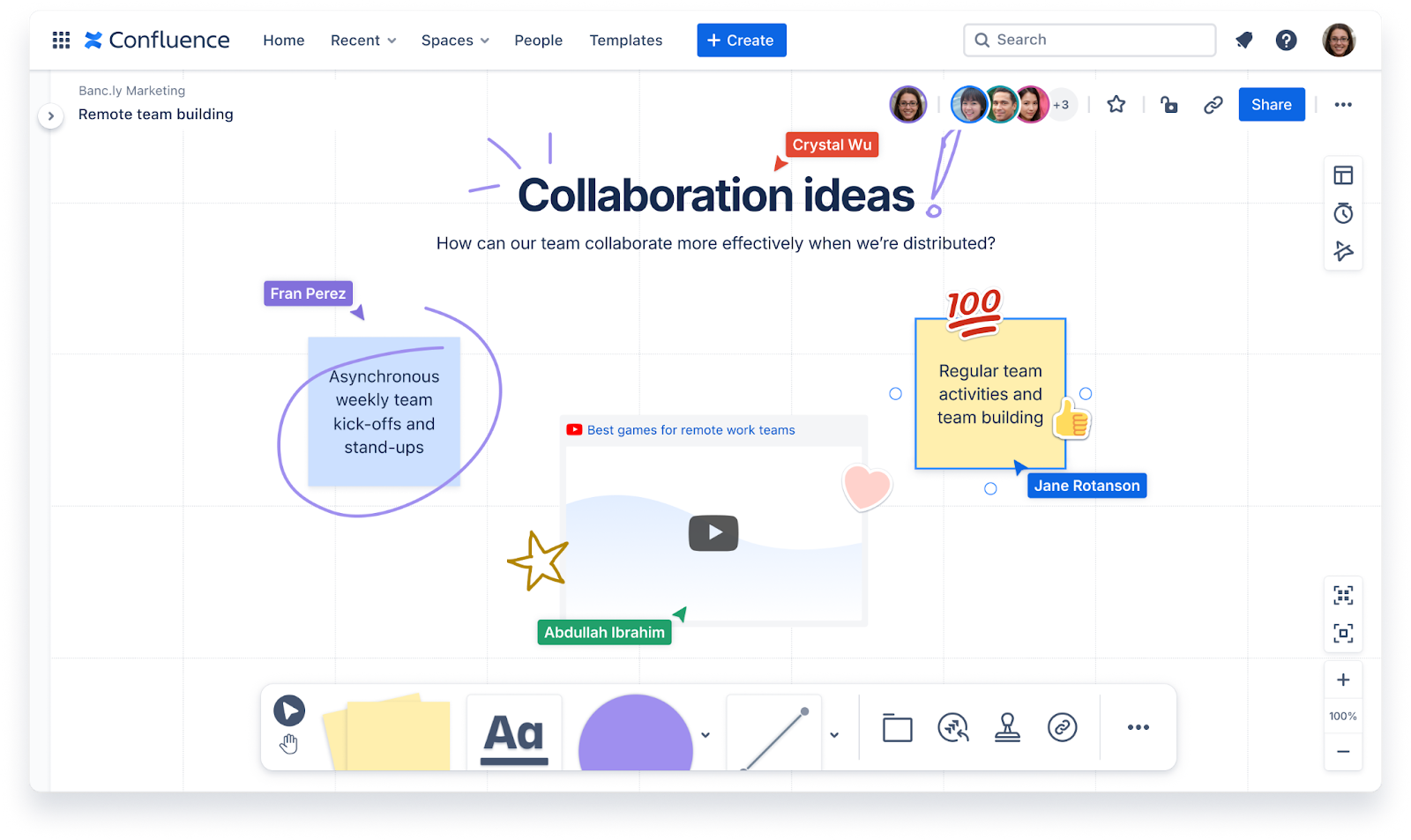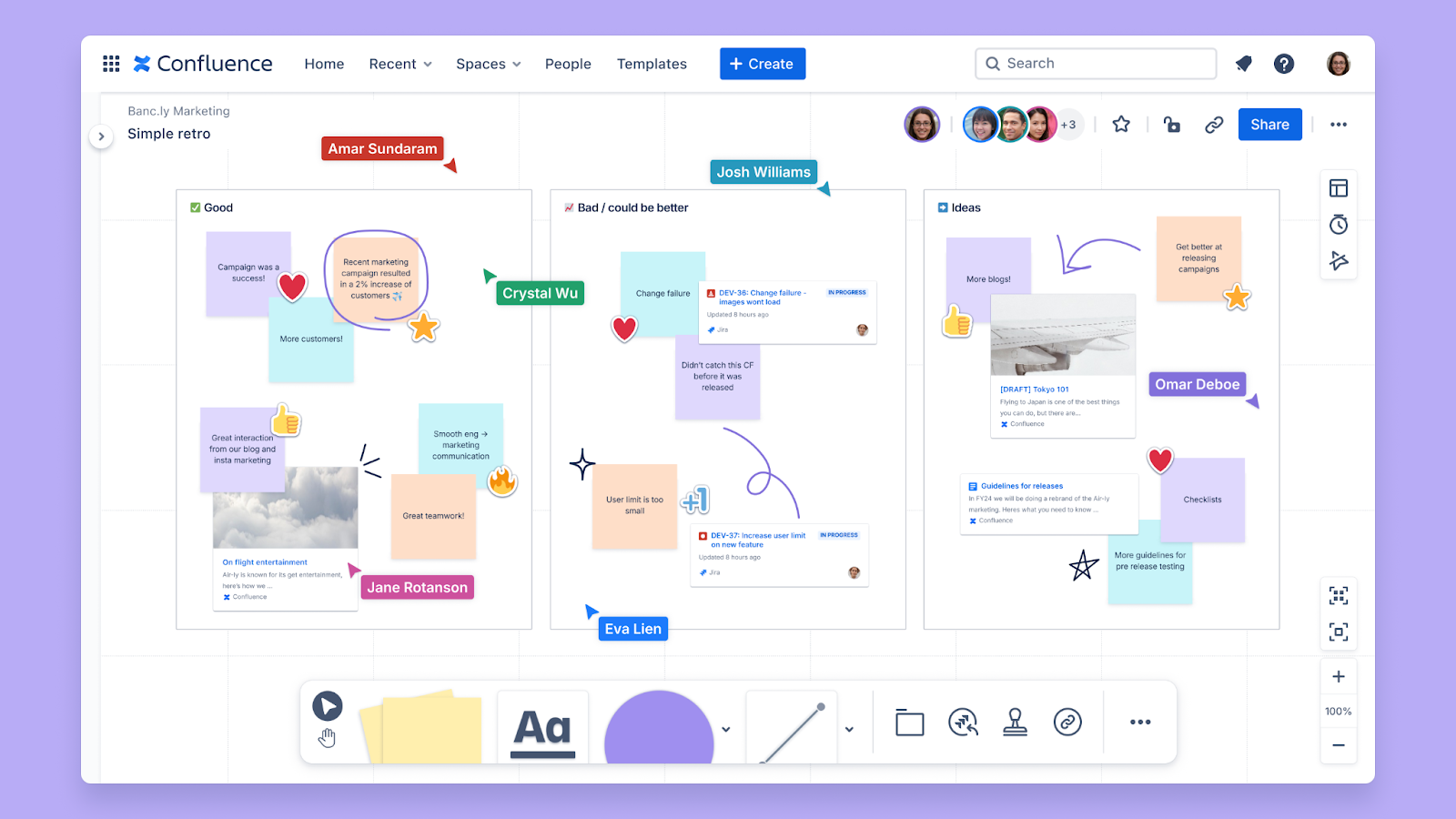How to use Confluence whiteboards to build team alignment
Managing cross-collaborative projects or campaigns leaves a lot of room for potential confusion or discrepancies. As a project takes shape, people in different departments might make changes that don’t make sense or work on tasks outside of the scope, goals, and budget.
With so many different people involved in one campaign or project, communication is paramount — and prone to inconsistency. For example, let’s say the marketing team launches a big promotion or campaign without looping in sales or customer service, resulting in an onslaught of unexpected demand or inquiry.
Teams that are scattered across different locations or time zones make course-correcting or resolving issues quickly even harder. However, these challenges and setbacks can all be prevented with successful team alignment.
When all stakeholders are aligned, everyone is clear on objectives, understands constraints and priorities, maintains consistent messaging, and keeps projects on track. But how do you achieve that team-wide harmony? Implement proven methods that improve visibility, clear communication, and a unified understanding of objectives with the help of Confluence whiteboards.
Activate Confluence whiteboard features to build team alignment
Confluence whiteboards are the ultimate tool for implementing all of these best practices. It provides a shared collaborative space to map out projects and communicate all in one place, so everyone involved is on the same page at all times.

Whiteboard features allow you to build project timelines, discuss and determine priorities, and develop ideas and steps for every project or campaign. Here are the ways to leverage each feature to align all stakeholders:
Voting
In whiteboards, you can use stamps to vote on ideas placed on stickies or other parts of the space. This is an easy way for all the relevant stakeholders of a project or campaign to make decisions together based on everyone’s input. For example, the leaders of a project can use a stamp like a thumbs-up or plus-1 emoji to identify priority tasks for the team. Or, the creative team can use heart or star emojis to select their favorite visual assets or copy for a campaign.
Stickies
Virtual sticky notes enable you to quickly and easily jot down ideas and place them on the whiteboard. They have a wide range of applications. Marketing teams can use them to brainstorm elements of an overall marketing strategy for a product or client or for an individual piece of content. Project managers can use them to arrange the order of a project timeline or construct the different steps of various work processes.

Stickers and stamps
Beyond voting, stickers and stamps are useful for leaving visual feedback whenever you want quick input from the team. For example, team members can add stickers to whiteboards during retrospectives to show how they feel about different aspects of their own work or the project as a whole.

Comments and mentions
When you need to discuss ideas further with teammates or add more context and detail than stamps can provide, use comments and mentions. Add your thoughts to a sticky note with a comment, or use a comment to tag individual stakeholders and bring their attention to specific parts of the whiteboard.
For example, someone could leave a comment and tag the project manager about how they would modify or rearrange part of a process. Or, a team lead could ask an account manager to present to a client an element of a strategy laid out on a whiteboard by mentioning them in a comment.

Templates
Confluence has plenty of ready-made templates, so you can follow a proven framework for different exercises if you don’t want to start from scratch. Some that are particularly useful for stakeholder alignment include:

- Prioritization matrix: A clear and easy way to visualize what should be done immediately and what can be done later or assign levels of importance to certain tasks. You can also categorize tasks with signifiers like “must have” and “nice to have.”
- Network of teams: A chart identifying every stakeholder involved in a campaign or project and what their role is. Whiteboards are the perfect collaborative platform for running a live network of teams exercise to determine the types of teams and their level of involvement.
- Annual calendar: A calendar to plan kickoffs, deadlines, and other key milestones and timing for projects and campaigns.
Public links
Once you’ve finalized a whiteboard or want input from your external stakeholders, you can share it with a public link. For example, agencies can share editorial calendars with clients for approval, or clients can share briefs or idea boards for campaigns with their agency partners.
To learn more about public links, check out this article.

